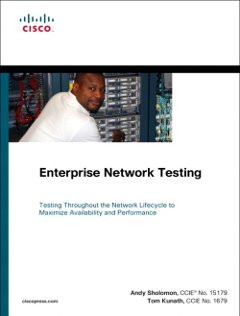Review: Enterprise Network Testing
By stretch | Monday, May 30, 2011 at 1:03 p.m. UTC
I recently received a review copy of Enterprise Network Testing, a Cisco Press title written by Andy Sholomon and Tom Kunath. The book covers all aspects of formal network equipment and design testing for large networks to reduce operational risk and improve overall network uptime.
The book is divided into three parts: an introduction to enterprise network testing, case studies, and example test plans. The first section comprises five chapters which serve as the core of the book. The second section provides half a dozen easily digested case studies of testing performed on real-world networks. The final section provides a number of exemplary test plans specific to certain technologies (e.g. IPv6 and MPLS VPNs) which can be used or adapted for use in the reader's own lab.
Whereas the case studies and test plans are mostly standalone reference content, the first few chapters should be read in sequence. A brief synopsis of each is provided here.
Chapter 1: A Business Case for Enterprise Network Testing
Most of the benefits of network testing explained here will be obvious to experienced network engineers, but it is helpful to have them laid out in black and white when you need to justify a funding request. The authors also provide some dollar figures relevant to average downtime costs per industry (which may or may not be accurate).
Chapter 2: Testing Throughout the Network Lifecycle
Chapter 2 serves as the requisite dry marketing chapter required of any Cisco Press book and discusses how network testing relates to each phase of Cisco's PPDIOO lifecycle (prepare, plan, design, implement, operate, optimize). As abstract writing goes, this chapter isn't too bad.
Chapter 3: Testing and Lab Strategy Development
Here the book discusses cost analysis for and the typical operation of a dedicated test lab in a larger organization. While no doubt of value to medium-to-large businesses, smaller organizations without dedicated lab space and personnel won't get much out of this chapter.
Chapter 4: Crafting the Test Approach
This chapter and the next comprise the book's detailed testing methodology. Chapter four begins by discussing typical motivations for network testing and how to determine test scope, and describes many of the tools used in network testing (stateless and stateful packet generators, network delay and impairment tools, etc.). It also provides guidance on how to write an overall test plan and produce detailed test cases.
This chapter is available as sample content from Cisco Press.
Chapter 5: Executing the Test Plan
The first part of the book ends with some practical discussion of test execution. This includes some pointers on configuring an out-of-band management network, how to test for things like delay and high-availability failover, some test tools built in to Cisco IOS, and how VRF Lite can be leveraged to emulate hundreds of routers on a network. This chapter concludes with some very helpful tips on checks to make before, during, and after each test.
Overall
This book addresses an often neglected niche of network design and engineering: testing your network to ensure it will really do what you expect it will. While the sections on establishing and maintaining dedicated testing labs will likely exceed the capabilities of many smaller organizations, the many years of practical testing experience presented in this book make it well worth the read for every networker. The test case templates alone will save an engineer dozens of hours of trial and error attempting to reinvent the wheel in his or her own lab. And at a higher level, it's always nice to have a written reference to act as a sanity check when developing tests of your own.
Posted in Reviews
Comments
May 30, 2011 at 11:39 p.m. UTC
Thanks for this review. I'd already purchased the book through the @CiscoeBookDeal but it's good to see some feedback from someone with a little more field experience. Building up quite an impressive professional library!
Thanks in general, too, for the great work you do with this site; it's already inspired me quite a bit. Looking forward to delving deeper into some of the technologies that you post about here.
Cheers.
May 31, 2011 at 4:24 a.m. UTC
Thanks for the tip, interesting topic and started reading the PDF.
May 31, 2011 at 12:15 p.m. UTC
Very interesting book, one more added to my book collection! Thanks for the hard work stretch!
May 31, 2011 at 3:36 p.m. UTC
Thanks for the review! Started reading a few days ago, so far you are spot on.
June 15, 2011 at 8:20 p.m. UTC
I recently had to test a newly deployed large enterprise network (over a 150 switches) and picked this book up to give me some help. This book helped with sorting out tests that are required before passing it to the support team to evaluate for acceptance into support.
Its definitely worth reading. It would be good if they include a sample test report within it though. I had to rely on cribbing notes from Opus reports to create a report.
Ultimately testing generates a test report. That could have been covered better and also methods of measuring failover could have been covered better. Still worth getting despite this.
June 23, 2011 at 11:54 a.m. UTC
You did a very thorough review there.
This book seems interesting and a must-have for networkers like me.
July 13, 2011 at 11:28 p.m. UTC
I stumbled onto your review, during one of my periodic raids on your knowledge, right as I'd been tasked with creating a Network Ready for Use Test plan for a large hospital network going live in a week.
I bought this for my kindle and it was an amazing reference guide. This is one of those books that never really gets outdated.
Thanks for reviewing.

